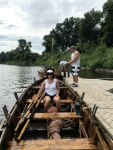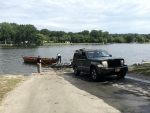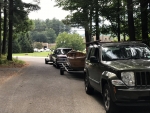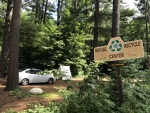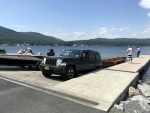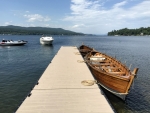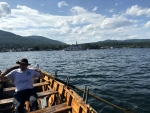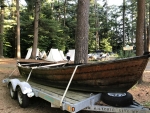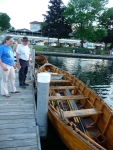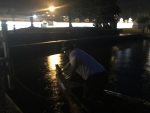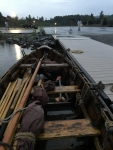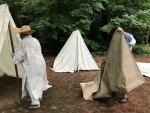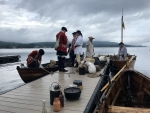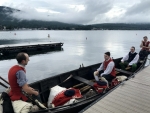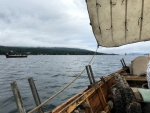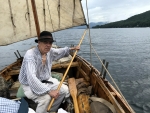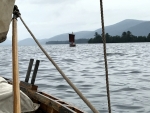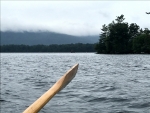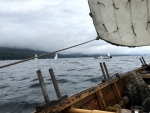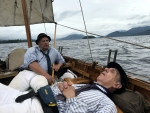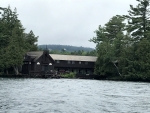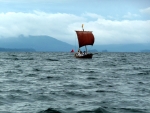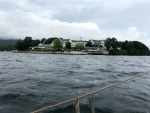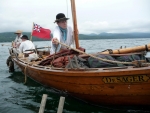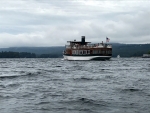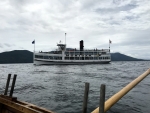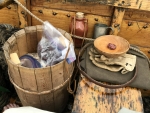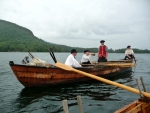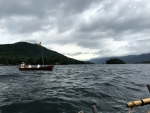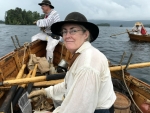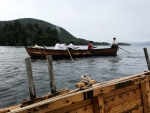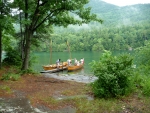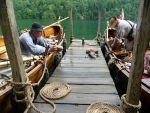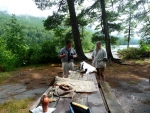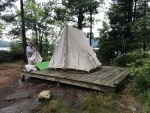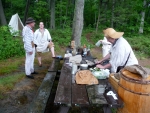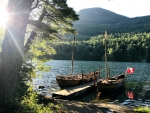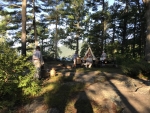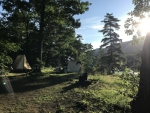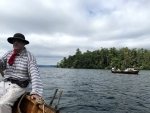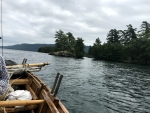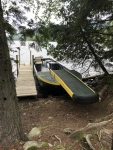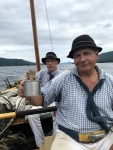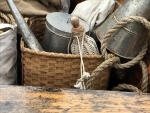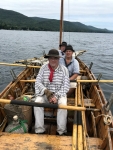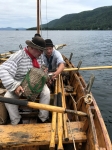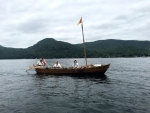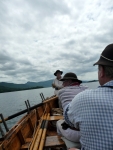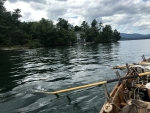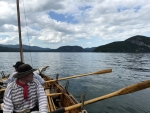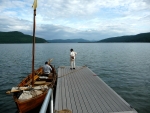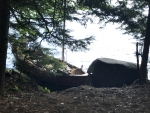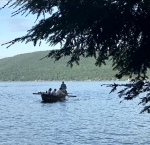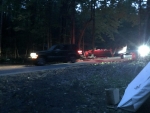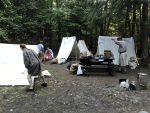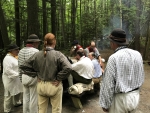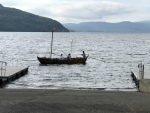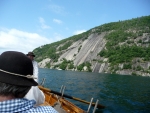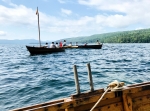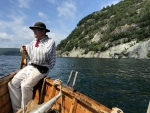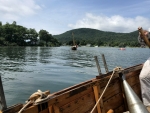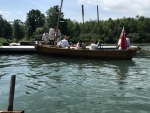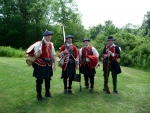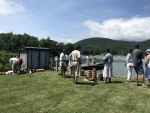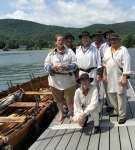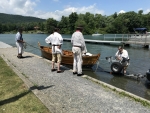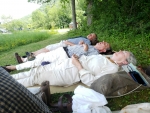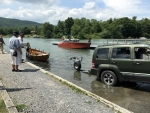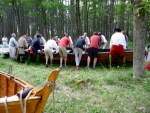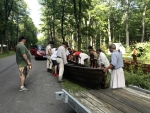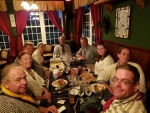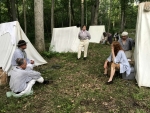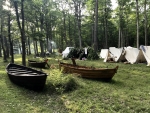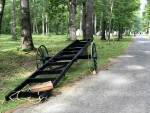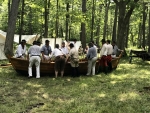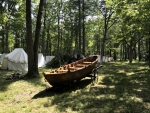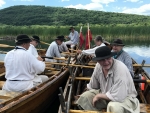Photos were taken by Peggy Huckel, Bill Manthey, and David Manthey, and are copyright by the person who took them. Text is by myself, David Manthey.
Tuesday, 16 July 2019 – Lake George Battleground Park
This year’s plan is relatively simple – row down Lake George, possibly portage to Lake Champlain, and participate in Fort Ticonderoga’s “Montcalm’s Cross” event. This simplicity belies a complexity of logistics. The Fort’s bateau is joining us, but relying on our trailer and transport, which gives us three boats to transport on two trailers. Once near Fort Ticonderoga, we want to position the boats for a portaging demonstration. This demonstration also required the bateau wagon. Further, the carpenters at Fort Ticonderoga want to build an artillery raft which we would need to tow at times.
To add to the boat and trailer logistics, the exact number of rowers for Ticonderoga’s boat was still in flux until almost the last moment. We would have seven rowers for two days, then somewhere between 8 and 10 for one day. We decided to take both of our boats for the whole trip, though perhaps this was overly ambitious when we had just seven rowers.
In retrospect, it would be best in the future to not run a boat with only a crew of three – it is hard to give any one rower a break without losing way against a head wind. We’ve done enough trips, that we don’t need to prove that we can do something despite it being hard; we know we can, and now we can choose when to do hard things and when to take it easier.
Since last Saturday was the Canal Fest at the Mabee Farm, our boats were still at our dock on Tuesday morning. Around 10 in the morning, Kevin, Rick, Peggy, Harvey, Susanne, and myself met at the Farm. As usual, we first moved the trucks and trailers from the Farm to the boat launch. We then rowed the DeSager and the Bobbie G from the dock to the boat launch and put them on the trailers. This was a pleasant morning row.
Harvey and Susanne departed – they weren’t coming on the main rowing trip. Peggy left to go home and intended to be picked up by us en route. Rick, Kevin, and myself drove to my house to pick up the bateau wagon.
The bateau wagon comes apart in five awkward pieces, plus miscellaneous fastenings, tools, and wheel chocks. The three main pieces went on my car’s roof rack; this is ever so much easier when done by two people who aren’t short. The wheels were transported in one of the boats. While we were loading the wagon, Heather supplied us with refreshing watermelon.
In the meantime, Peggy’s car had an issue with the heat shield, which altered how we were to meet up with her. We proceeded to a diner along our already planned route for lunch and to wait for Peggy. She showed up in good order, with her car issue resolved. We then proceeded to Lake George Battleground Campground in the two trucks with trailers and my car with bateau wagon.
The person manning the campground office reveled in the bureaucracy of the New York campground system. This seems a tedious waste of time without much benefit – I don’t grasp the utility of knowing which person would be on which site of the multiple sites I had reserved.
Once we had checked in, we pitched one tent, then offloaded the trucks and anything stored in the boats that we needed overnight. We stashed things we wanted out of weather or sight in the tent. Once we had done this, we drove the short distance to the boat ramp at the Million Dollar Beach.
Due to the vaugaries of Lake George Village, we can leave boats on the town dock, but not between the hours of 5 a.m. and 9 a.m. We can’t leave boats on the boat launch dock, and the beach areas are restricted to boats. We tried to get an exemption for any of these. The people from the town and the park were all friendly, but each felt that they didn’t have the power to give an exemption. Perhaps if we had tried harder we could have found a way, but we didn’t do so for this trip. As such, we need to move the boats from the launch to the town dock, pay a dockage fee, then move them off the dock by 5 a.m.
After launching each boat, we sent Kevin and Rick away with the trucks and empty trailers. We’ll leave Kevin’s truck with the bunk trailer at Mossy Point. Rick and Kevin will pick up the Fort’s boat at the DEC launch at Ticonderoga Ferry along with their crew. They drove off in good order. I communicated with the Fort about our timing so that their rowers would have their boat at the DEC launch at the appropriate time.
While Rick and Kevin moved vehicles, Peggy and I rowed one boat at a time from the boat launch dock to the town dock. This is around 3/4 of a mile, and goes past the swimming beach, the dog beach, and the steamboat dock. After moving the first boat, we walked back to the boat launch and repeated with the second. We talked with a ranger who knew a fellow boater. Peggy also tried to get permission to use the town dock after 5 a.m. to no avail.
Once we had rowed the boats over to the town dock, we walked back to our campsite. We had erected another tent when our additional crew arrived – Reb, Bill, and Judy. We finished putting up tents and made a fire in the braziers for dinner. We did the standard chores we always need the evening before the rowing trip – filling water jugs, sorting food, etc.
Rick, Kevin, and four crew from Fort Ticonderoga showed up in good order along with the Fort’s bateau. We got them checked in at the campground – this time with a minimum of bureaucracy as a different attendant was on duty. They are one site over from us; we would run this way for the trip – near but not on top of each other.
We had dinner and sorted more gear. Since we have to launch the Fort’s bateau in the morning, we used it as a temporary transport for things we wanted to put in our boats. Those who wanted to row in the morning took a stroll down to the town docks to make sure they knew where we would need to go in the early hours.
A tiring day, and we haven’t really started yet. We rowed each boat around 2.8 miles today between taking them out at the Farm and moving them to the town dock.
Wednesday, 17 July 2019 – Floating Battery Island
We woke up around 4:20 to make sure we had enough time to get to the town dock before 5 a.m. We left Judy and Kevin at camp to make breakfast while we moved boats; the rest of our crew walked down the hill from the campsite to the town dock. Unsurprisingly, no one else was about at this time.
There were three other boats at the town dock besides our two bateaux. I don’t know what their owners do; perhaps if they see a mooring enforcement person, they just motor away.
We got the oars up, then crewed out the boats. We were off the dock and rowing 5 minutes before we strictly needed to be. The row to the boat launch dock was pleasant and misty. After tying up at the launch dock, we walked back to camp.
After a breakfast of Rolf’s sausages and eggs we struck our tents. The ground was fairly dirty and damp enough that various bits of plant detrious stuck to the tents. We loaded all of our gear into the Fort’s bateau for transport. At the neighboring campsite, the Fort’s crew was up and ready faster than we were – they are travelling light, plus didn’t get up to move boats.
We drove or walked down to the boat launch, passed through the boat inspection station, then launched. After launching, we shifted gear between boats until all was sorted out. The drivers moved the cars from the boat launch to a parking area where we could leave the vehicles for several nights, then walked back to the boat launch.
A reporter from the Lake George Mirror stopped by to take pictures of us and talk a little. They ended up running an article about our trip.
Shortly after 8, we pushed off and started rowing. Kevin, Reb, and Judy are in the DeSager. Rick, Bill, Peggy, and myself are in the Bobbie G. The Fort’s bateau has their crew of four.
The weather is shredded low-lying clouds nestled in the hills with light wind. The wind is fluky but mostly from the south or southeast, so we put up our sails. The Fort’s bateau doesn’t have a sail, so they were in for rowing all day. Off we went.
Determined to use the wind as much as possible, we initially did very little rowing. The Fort’s boat kept abreast of us under oars, sometimes getting slightly ahead and sometimes falling slightly astern. Very few other craft were out at the time; a lake patrol boat was about all we saw for the first hour or so.
Naturally we passed some of the lovely islands in the lake. The low clouds made it easy to see which islands were closer and which were further; on a clear day this is much harder.
By 10 a.m. the wind had a distinctly eastern component. Before, when the wind was nearly due south DeSager with her square sail was faster than the Bobbie G with the lug sail. As the wind veered to the side, the speed advantage switched; the lug works better on the beam.
We saw a handful of small sailboats with kids sailing around. A small school of them came out close to us, tacked neatly, and scudded back toward shore.
Shortly after noon we neared the Sagamore Hotel. Here the Morgan passed close by. Peggy knew the captain, and we exchanged a brief conversation. The Mohican also passed us and fired a small salute gun as it went by.
As we approached the Narrows we loitered eating lunch. Lunch was sausage, cheese, fruit, and peppers. Over the years we’ve gotten much better at having vegetables as part of our in-transit meals. As the Bobbie G was ahead of the other two boats, we dallied a bit to give them a chance to come up. We wanted to make sure no one headed into Northwest Bay, as it would require working back against the wind to return.
As the Fort’s boat reached the Narrows, it started to rain and the wind failed. As the rain was warm, this wasn’t unpleasant. Fortunately the predicted thunder and lightning didn’t materialize. We continued under oars.
We passed by the various islands in the Narrows, then rowed the several miles to the next island group. Our destination for the evening came up relatively quickly. Floating Battery Island has several campsites. We had reserved three on the eastern side of the island.
The rain had mostly abated, though it came and went a bit.
Once we had the boats tied up, we examined the campsites to pick out where we wanted our tents. Each site has a wooden platform. We put up a tent on each of these, wedging the stakes between the wooden boards as we could. Since it had been raining, other areas were muddy or weedy in turns. We found enough space for a few more tents.
We watched osprey fish between us and the main land. We enjoyed the ragged clouds and occasional shower. We were amused by a duck that appeared to be a cross-breed between a mallard and a black duck.
The island campgrounds are administered by different ranger offices, and, for some reason best known to them, you are supposed to check in at the administration office, even though the campgrounds have been reserved in advance. For Floating Battery Island, this would mean an extra 6.5 miles of rowing to check in at Narrow Island and return – not very practical. While we were setting up camp, a park boat motored within shouting distance of the dock, and a ranger rudely told us that we had to register at Narrow Island the next morning and that “it is not a choice”. To give her the benefit of the doubt, perhaps she had just dealt with someone unpleasant. However, this exchange was unsavory.
Kevin fixed a delicious dinner of chicken in onion sauce and rice with spinach.
After dinner we speculated with the Ticonderoga crew on how to improvise a sail for their boat. We lent them the “kitchen table” (an all-purpose piece of canvas that we carry), some spare tent poles, and some rope.
We all turned in early – the 4 a.m. wake-up call had caught up with us.
Total distance today around 17.4 miles for each boat, bringing the trip total to 20.2 miles.
Thursday, 19 July 2019 – Rogers Rock Campground
A relatively lazy start to the day. The forecast is for light northerly winds abating sometime between 9 a.m. and 2 p.m. depending on the prediction source and then veering to the west and south. Given this, a slow start will take less time and effort than a fast start.
The weather cleared overnight, and the day was promising to be hot and sunny. We breakfasted on bacon and eggs. We struck camp leisurely and loaded the boats.
As we were doing this, a park boat came by and a friendly ranger asked us to register when we passed Narrow Island. Although the request was ultimately the same as from yesterday’s ranger, there was a world of difference in the tone.
We set out some time between 9 and 10, rowing into the slight head wind.
Once on the lake, we saw a strange maintenance craft with a long passerelle on the front. When we first saw it, there were two crew members and a ladder laid flat on the passerelle. Later, the ladder and one crew member were gone.
The row seemed quite slow into the wind. The sun was quite hot. We passed small islands just off of Huletts Landing. Some kids were swimming off of on idyllic spot.
After two hours or so of rowing, we reached Narrow Island and dutifully reported to the campground office. They were very pleasant. While we were fulfilling our bureaucratic duties, the Fort’s bateau passed by at a distance; they sensibly weren’t stopping. When we pushed off again, we did a morning rum and cookie break. DeSager came alongside, and we proceeded on.
Here we let Peggy steer and took turns rowing. Despite the forecast, the head wind would continue most of the day. We frequently refilled canteens. We occasionally drank shrub.
This was a classic long day of rowing, averaging just under 2 miles an hour, mostly due to the head wind. We sang songs. We told stories. We admired the hills, the water, and the camps. We waved at passing boats. We rowed.
Peggy had her copy of Pedini’s guide book. We tried to get Bill to use it to give us commentary on visible landmarks, but it wasn’t a brilliant success.
We passed Slim Point, failed to really notice the town of Hague, went by the Waltonian Island group. At one point we spotted the Ticonderoga boat. The DeSager gradually slipped away behind us, though we could see her right until we rounded Friends Point. We gradually worked our way into Cooks Bay and to Rogers Rock Campground.
We tied up to the dock at the campground’s boat launch around 5:30. I went off to check in and see where we could move the boats to be near our campsite, leaving the others at the dock to make sure the other boats didn’t pass by.
After return to the dock, we moved the Bobbie G to a spot on the shore at the bottom of a hill leading to our campsites. This hill didn’t seem that bad when I had selected the campsites; now it seemed quite steep. We left Bill on the dock to direct other boats.
As we were unloading the Bobbie G, the Fort’s boat arrived. We signaled them to land near us, which they did. Oddly, we didn’t see DeSager, though I had expected that they were less than a half hour behind us.
Here we started to fret. Peggy remembered to check her phone – the crew of the DeSager had tried to call. We called them. Despite having been to Rogers Rock Campground on at least three previous occasions, they had misremembered which side of Rogers Rock it was on and had passed by. The wind had finally turned southerly, and they were under sail a mile and a half north of where they needed to be. This was a mild fiasco, as they were headed to Mossy Point and our gear was split between the boats.
In the meantime, Tim arrived. He would be joining us on Friday. This was the saving grace of the situation. First he drove to fetch Bill from the dock so he didn’t have to walk from the launch to the campsite. Next he helped lug gear up the hill as we set up camp and started making dinner.
While DeSager continued north, we made a contingency plan. Since we had Kevin’s truck and the bunk trailer at Mossy Point, I had a copy of his car key, and Tim had a car, we had a solution. We conferred via phone with the DeSager crew once they had arrived. We left dinner to cook under the watchful eyes of Rick, Bill, and Judy. The Ticonderoga crew was contentedly setting up their own camp.
Tim drove myself to Mossy Point. Here we used Kevin’s truck to pull the DeSager out of the water. We loaded the crew into the truck and car, then drove back together to Rogers Rock campground. This took a long time, even though the distances weren’t great.
Back at camp, we finished setting up tents and laying out bedding. We finished cooking dinner – a simple ham, potato, carrot, and ginger boil. We ate ravenously and discussed the plans for tomorrow.
After three or four very fretful hours, we had managed to recover our situation. All of the boats and crews were together. We went to our much needed beds.
Total distance for the day, 14.2 miles for Bobbie G and 16.6 miles for DeSager. Total distance for the trip 34.4 and 36.8 miles, respectively.
Friday, 20 July 2019 – Fort Ticonderoga
We breakfasted on oyster hash and scrambled eggs. Once fortified, we set about recovering from yesterday.
We struck camp and loaded some gear into vehicles rather than lugging it down the hill to the Bobbie G. We rowed the Bobbie G over to the boat launch. The Fort’s boat joined us.
We trailered the DeSager to the boat launch and refloated her. We then transferred some gear between the boats. We sent an away team to return the boat trailer and truck back to Mossy Point. They returned in Tim’s car.
Finally, we were sorted out and where we had intended to be last evening. The three boats were at Rogers Rock campground and a truck and trailer at Mossy Point. We set out a little after 10 in the morning. We now had four people in each boat, Tim having added in to the DeSager.
For DeSager, this was repeat of last evening, but without the worry of being in the wrong place. For the Bobby G and the Fort’s boat, this was on plan. We passed the impressive Roger’s Rock, then gradually worked our way down the narrowing lake.
The distance to Mossy Point is only 4 miles, and we covered it easily, each boat staying in sight of the others. Mossy Point appears suddenly around a corner, and we headed in.
After tying up, the Fort Ticonderoga crew attired themselves in full military kit. Tim joined them, and they all marched off toward the Fort, a land distance of four miles or so. The weather is very hot today, and they were wearing many layers of wool.
We used the truck and trailer to take out the Bobbie G. Kevin and Reb drove her away to position her along the road in Fort Ticonderoga for a portaging demonstration tomorrow.
While waiting, we watched an in-production Hacker craft launch and then recover to test engine and pump.
Eventually, Kevin returned and we took out the DeSager. Tim returned and drove the various drivers back to Lake George to fetch the other truck and the two cars we had left there. We drove back to Mossy Point and, hours later, loaded the Fort’s boat on the flatbed trailer.
Finally, we all ended up at Fort Ticonderoga. The heat was intense. We very gradually got all three boats positioned on the ground near our camp for tomorrow’s event.
We got camp set up, now joined with many more reenactors who had arrived via more conventional means. We assembled the portage wagon. We watched as some of the Fort’s carpenters worked on a raft they hoped to use for transporting a cannon on Sunday. We sweated in the heat and swatted mosquitoes.
Our fellow crew member Joanna was at the Fort and joined us in setting things up and shifting boats about.
We all went out to the Burgoyne Inn for dinner. A long day, despite a short rowing distance.
Total distance for the day, 4.1 miles for Bobbie G and 3.8 miles for DeSager. Total distance for the trip 38.5 and 40.6 miles, respectively.
Saturday and Sunday, 21 and 22 July 2019
On Saturday we did some portaging demonstrations. We had a lot of reenectors helping.
For the DeSager, we picked up the boat walked with it together. Being comparatively light and empty, this was relatively easy and quick. The ground was fair, and it wasn’t much trouble.
The much bigger Fort’s bateau couldn’t be carried the same way. Here we did the iterative lift-and-shift approach. Everyone heaved together, picking up the boat and shifting it forward a foot or so and then set it back down without shifting their footing. This is relatively sure and safe, but very slow and a lot of work.
The Bobbie G was placed on the bateau wagon. Once on the wagon, it was easy to trundle it on the grassy ground and was clearly the fastest of the various methods.
On Sunday, we rowed around below the fort, hopefully entertaining or interesting any visiting public.
